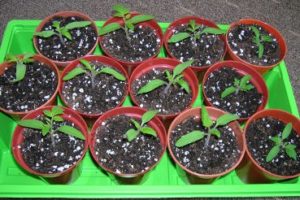Watering alone is justified if the seeds are sown in fertile soil. But if it is poor, for example, you dug it up in a garden where organic matter has not been introduced for a long time, then top dressing is necessary.
Planned top dressing
From germination to planting in open ground, tomatoes spend 50-60 days in pots. During this time, they need to be fertilized 4 times:
- when 2 or 3 true leaves appear;
- 10 days after the first;
- 10 days after the second;
- a week before planting seedlings in the ground.
The best fertilizer for tomato seedlings is any liquid organic fertilizer, such as Vermicoff or Biohumus. Others will do, but it is important that there is little nitrogen in the composition – at the initial stage of tomato growth, they need enhanced nutrition with phosphorus and potassium (1). Fertilizers are diluted according to the instructions, and then watered in the same way as with ordinary water. After watering, it is useful to powder the soil in pots with ash – this is an additional top dressing. With this combination, young plants will receive all the nutrients they need.
Feeding seedlings with mineral fertilizers is not worth it. The main element that seedlings need is nitrogen. And mineral nitrogen fertilizers are very aggressive. It is worth a little overdoing it with a dose, the root system can “burn out”. Therefore, it is better not to experiment.
Feeding with a lack of nutrients
When tomatoes grow in poor soil, everything is clear there – they need a full-fledged complex top dressing. But it happens that the bulk of the nutrients are in abundance, and not enough of one. How to understand what tomatoes did not receive and what to do?
You can determine the lack of a particular element by the leaves.
Lack of nitrogen
Signs. The leaves turn yellow, the veins on the underside turn red.
What to do. Spray the leaves with mullein infusion – 1 liter of infusion per 10 liters of water. Or liquid biofertilizer according to the instructions.
Lack of phosphorus
Signs. Leaves curl inwards.
What to do. Spray the seedlings with an extract of superphosphate – 20 tbsp. spoons of granules pour 3 liters of boiling water, put the container in a warm place and stand for a day, stirring occasionally. Then dilute 150 ml of the resulting suspension in 10 liters of water, add 20 ml of any liquid biofertilizer (it contains nitrogen, and phosphorus is poorly absorbed without nitrogen) and mix well.
Lack of potassium
Signs. The upper leaves are curled, and a brown dry border appears on the lower edges.
What to do. Feed the plants with potassium sulfate – 1 tbsp. a spoon without a slide for 10 liters of water.
Lack of calcium
Signs. Light yellow spots form on the leaves, and new leaves grow awkwardly large or deform.
What to do. Spray the plants with infusion of ash or calcium nitrate – 1 tbsp. a spoon with a slide for 10 liters of water.
Lack of iron
Signs. The leaves turn yellow, but the veins remain green.
What to do. Spray the seedlings with a 0,25% solution of ferrous sulfate.
Lack of copper
Signs. The leaves are pale with a bluish tint.
What to do. Spray with a solution of copper sulfate – 1 – 2 g per 10 liters of water or copper sulfate – 20 – 25 g per 10 liters of water.
Lack of boron
Signs. The upper point of growth dies off, many stepchildren appear.
What to do. Spray with boric acid – 5 g per 10 liters of water.
Lack of magnesium
Signs. The apex turns pale, pale green, yellow, and then brown spots appear on and near the green veins. Petioles become brittle.
What to do. Spray with a solution of magnesium nitrate – 1 teaspoon per 10 liters of water.
In general, it is useful to water the seedlings in advance with a solution of trace elements (2):
manganese sulfate – 1 g;
ammonium molybdate – 0,3 g;
boric acid – 0,5 g.
These norms are for 1 liter of water. And you need to use such top dressing not for watering, but for leaves – sprinkle plants from a spray bottle. They give it 2 times: 2 weeks after picking and 1 week before planting seedlings in the ground.
Popular questions and answers
We talked about feeding tomato seedlings with agronomist-breeder Svetlana Mikhailova – they asked her the most pressing questions of summer residents.
How to feed tomato seedlings after germination?
How to feed tomato seedlings so that they are strong?
– she lacks light;
– The room is too hot.
In order for seedlings to grow strong, they need to provide illumination for 12 hours a day and a temperature not higher than 18 ° C. If this is not possible, you can feed it with superphosphate every 2 weeks – 2 tbsp. spoons for 10 liters of water. Such top dressing will slow down its growth.
Is it possible to feed tomato seedlings with yeast?
Sources of
- A group of authors, ed. Polyanskoy A.M. and Chulkova E.I. Tips for gardeners // Minsk, Harvest, 1970 – 208 p.
- Fisenko A.N., Serpukhovitina K.A., Stolyarov A.I. Garden. Handbook // Rostov-on-Don, Rostov University Press, 1994 – 416 p.










